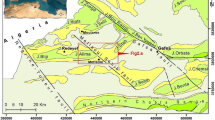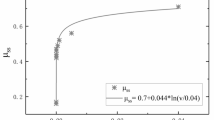Abstract
An analysis is made of changes in the condition of permafrost due to residential and commercial development in different areas. The changes have been associated with an intolerably large number of deformations and failures of structures in the permafrost zone. An understanding of the geocryological-engineering processes involved in technogenic changes to permafrost will make it possible to accurately predict those changes.
Similar content being viewed by others
References
M. I. Sumgin, S. P. Kachurin, O. N. Tolstukhin, and V. F. Tumel,General Geocryology [in Russian], Izd. An SSSR, Moscow, Leningrad (1940).
G. Ostroumov, “Plan for the XXI Century,”Nauka i Zhizhn, No. 4, 2–11 (1995).
P. F. Shvetsov, N. G. Bobov, G. V. Porkhaev, and V. K. Shchelokov,Principles of Methods of Making Geocryological-Engineering Predictions in Mineral Prospecting [in Russian], Nedra, Moscow (1973).
I. Ya. Baranov, “Some observations regarding the characteristics of groundwater in areas with sporadic occurrences of stable frozen ground (town of Bratsk in the East Siberian Region),” in:Groundwater Resources in the Service of Socialist Construction [in Russian], Vol. 4, Moscow (1934).
N. G. Bobov, “Zonal character of the distribution of masses of perennially frozen rocks and prediction of the geocryological-engineering effects,”Vopr. Geokriol., 41, 91–101 (1971).
N. G. Bobov, “Formation of the geocryological-engineering conditions in areas of the permafrost zone of Russia that are under development,”Geokriologiya, No. 2, 82–87 (1998).
P. D. Bondarev,Deformations of Buildings in the Vorkuta Region, Their Causes, and Methods of Preventing Them [in Russian], Izd. An SSSR, Moscow (1957).
L. N. Khrustalev,Temperature Regime of Permafrost Soils in Developed Areas [in Russian], Nauka, Moscow (1971).
V. F. Zhukov,Pre-Construction Thawing of Perennially Frozen Rocks Under Planned Structures [in Russian], Izd. An SSSR, Moscow (1958).
Handbook for Construction on Permafrost [in Russian], Stroizdat, Leningrad (1977).
V. V. Baulin, V. I. Aksenov, G. I. Dubikov, et al., “Geocryological conditions in the development of the Bovanenkovsk deposit,” in:Geocryological-Engineering Monitoring of Industrial Activity in Yamal [in Russian], Vol. 2, Tyumen (1996), p. 240.
Additional information
Translated from Osnovaniya, Fundamenty i Mekhanika Gruntov, No. 2, pp. 29–32, March–April, 1999.
Rights and permissions
About this article
Cite this article
Bobov, N.G. Technogenic changes in permaforst and the stability of the foundations of engineering structures. Soil Mech Found Eng 36, 77–80 (1999). https://doi.org/10.1007/BF02469090
Issue Date:
DOI: https://doi.org/10.1007/BF02469090




